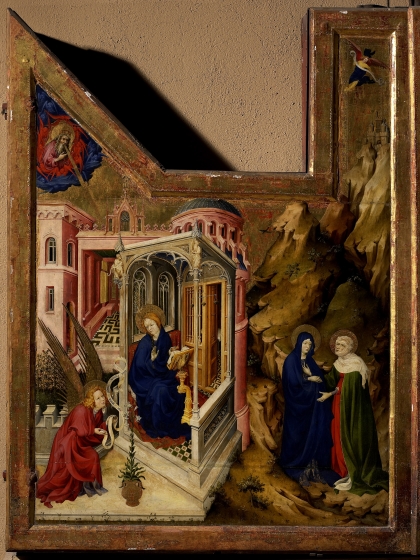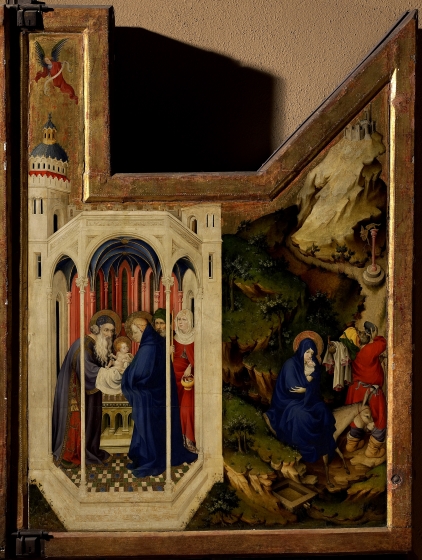This archived website 'Flemish primitives' is temporarily not being updated. Certain functionality (e.g. specific searches in the collection) may no longer be available. News updates about the Flemish primitives will appear on vlaamsekunstcollectie.be. Questions about this website? Please contact us at info@vlaamsekunstcollectie.be.
Melchior Broederlam
Melchior Broederlam is the most important Flemish painter of the generation before Jan van Eyck. In his early years he entered into the service of Lodewijk van Male, Earl of Flanders. After that he works as court painter and valet de chambre for Philip the Bold, Duke of Burgundy.
For the Carthusian cloister in Champmol near Dijon, in collaboration with the sculptor Jacob de Baerze from Dendermonde, he completes two works: the Crucifixion Altarpiece and the Retable of the Saints and Martyrs (Dijon, Musée des Beaux-Arts). The Duke is personally involved with this ambitious project. Broederlam, who has his studio in Ypres, receives the commission to paint the sculpture groups on the interior sides, to gild the frames and to paint the exterior panels with tableaux.
Only two of the painted exterior panels of the Crucifixion have survived the sands of time, while those of the Retable of the Saints and Martyrs have been lost. They serve as school examples for what people call the pre-Eyck art of painting. The left panel of the Crucifixion portrays the Annunciation and the Visitation, while the right panel depicts the Sermon in the Temple and the Flight into Egypt.
Broederlam is partially indebted to the tradition of the time, but he also distinguishes himself as a progressive artist. In the Biblical paintings based on traditional models, he knows to give a human dimension to a few figures, both in their physiognomy as well as their actions. In the Sermon in the Temple, which follows a traditional imagery scheme, he gives attention to the eye contact between mother and Child. The little child sits on the altar and clutches in his fist a lock of the beard of the High Priest Simon. The Flight into Egypt is an exceptional, original presentation. The theme takes on a folk character with the figure of the drinking Joseph. With the drinking container at his lips, he leads the donkey with Mary and Child onward and leads them along winding paths through an inhospitable landscape. The painting takes on a natural appearance with sand hills, rock formations, pygmy trees and rich flora.
A traditional aspect in the work of Broederlam is the rich use of gold leaf. Not only in the lighted areas, but also numerous details on clothing and textile were executed in gold. In order to enhance the optical effect of the precious metal, the decorative patterns are carried out in punched detail on the background, whereby punches of various thickness are employed. The accurate manner with which the artist knows how to render the precious gold-brocaded textile bears witness to an elevated technical know-how. The gold leaf is finely painted and worked over with punch and engraving instruments. The gilded frames bear the letters f and m, the initials of the given names of the patron Philip the Bold (Filips de Stoute) and his wife Margareta van Male.
Broederlam is a prominent painter and as with other painters from his time, he is a polyvalent artist. From archival documents we know that he also completed heraldic paintings, worked on mural paintings, designed glass windows and tile decorations and painted Ducal portraits. Burgundian accounting ledgers, with payments to Baerze and Broederlam in particular, provide a great deal of detail about the commission of the two paintings for the Carthusian cloister of Champmol. To this end, they are compared to existing works in Flanders, which, although now lost, decorated the altars in the Our Blessed Lady Church in Dendermonde and the Abbey of the Bijloke in Ghent. The two immense altarpieces for the Carthusians travel by horse and cart to and from Dijon.
?
Date of Birth and place (Ypres?) of Melchior Broederlam are unknown.
1381
Beginning in this year, Melchior Broederlam is the official painter of Lodewijk van Male, Earl of Flanders.
1384
Broederlam becomes court painter and valet de chambre for Philip the Bold, Duke of Burgundy.
1386
The painter receives the commission to paint the ceremonial carriage of Margareta van Male, daughter of Lodewijk van Male.
Between 1389 and 1392
He completes mural paintings in the castle of Hesdin.
25 May 1390
Jacob de Baerze, sculptor from Dendermonde, receives an advance payment for the purchase of the necessary materials for the completion of the two large paintings on commission for Philip the Bold, which are destined for the Carthusians of Champmol.
August 1391
Payment for the transport of the two, unfinished paintings from Dendermonde to Champmol. There, the Duke and his advisors can provide critique before they allow them to be further finished off.
February 1393
Payment for the transport of the two paintings from Dijon to Ypres to be coloured in the studio of Melchior Broederlam, gilded and then to provide the panels of paintings.
1394
Broederlam receives a sum of money for the purchase of pigments and gold leaf.
1398
In the summer, Broederlam is finished with the project. The painter also takes part in the packaging and transport of the imposing altarpieces, which travel precariously on carts in the direction of Dijon. For this, he purchases the necessary materials (leather, wood, iron, lead nails, etc.).
14 August 1399
A committee that consists of an official representative and a treasurer, the sculptor Claus Sluter, the goldsmith Hannequin de Haacht and the painter Jan Maelwael, receive the works and approve them.
12 September 1399
The Duke is extremely pleased with the painter's work. Broederlam receives a large sum of money for the services rendered.
1399
Payments refer to mason works with an emphasis on the placement of the paintings. That year, cloth is also ordered that is intended to cover the wooden backside of the altarpieces as protection against the rising humidity of the walls.
Today it is of the opinion that the Crucifixion Retable and the Retable of the Saints and Martyrs were designated respectively for the chapel of the Duke of Berry in the church for the former and the Chapter Hall for the latter.
1403
A final payment to Melchior Broederlam follows in connection with the paintings.
1406
Broederlam is paid to paint the portraits of the deceased ducal couple, Philip the Bold and Margareta van Male, on the walls of the ducal chapel in the Our Blessed Lady Church in Kortrijk.
1409
Final mention of the painter in the archival documents. He is probably still active for a few years following.
Dominique Deneffe








